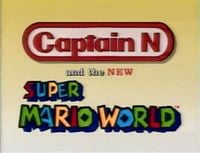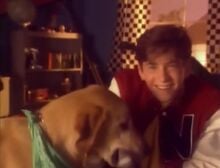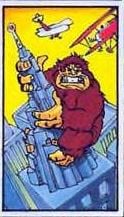Captain N: The Game Master
- Not to be confused with Captain N & The Video Game Masters.
| Captain N: The Game Master | |
|---|---|

| |
| General information | |
| Format | Children's television series |
| Creator(s) | Shigeru Miyamoto (characters) Andy Heyward (concept) |
| Director(s) | Kit Hudson Chuck Patton |
| Starring | Dorian Barag as Kevin Louie from CRITTERS OF THE CINEMA as Duke the Dog |
| Voice actor(s) | Garry Chalk Ian James Corlett Michael Donovan Matt Hill Alessandro Juliani Adnrew Kavadas Doug Parker Levi Stubbs Venus Terzo Frank Welker Tomm Wright |
| Composer(s) | Haim Saban Shuki Levy Michael Tavera |
| Country of origin | United States of America, Canada |
| Original language | English |
| Seasons | 3 |
| Episodes | 34 |
| Production | |
| Executive producer(s) | Andy Heyward |
| Producer(s) | Michael Maliani John Grusd |
| Production company | DIC Entertainment Saban Production Nintendo |
| Distributor(s) | Rysher Entertainment Shout! Factory Sony BMG Music Entertainment WildBrain Spark (current distributor) |
| Runtime | 22 minutes (season 1-2) 11 minutes (season 3) |
| Broadcast | |
| First aired | September 9, 1989[?] |
| Last aired | October 26, 1991[?] |
| Status | Ended |
Captain N: The Game Master is an animated television show produced by DIC Entertainment which spans three seasons and thirty-four episodes, involving a teenager who is transported to "Videoland", where he uses an NES controller and NES Zapper to lead a group of video game heroes against video game villains.
Captain N was also a segment of the Nintendo Comics System, but because of licensing restrictions, only characters from Nintendo-produced games appeared. Samus Aran and Uranos, who both never appeared in the show, were regular characters in the comic. Donkey Kong was a comparably much smaller character in the comics than the cartoon.
Overview[edit]
While playing Punch-Out!! on his NES, Kevin Keene is sucked into a vortex formed in the television, and his dog Duke jumps in after him. After falling through the Ultimate Warp Zone, Kevin lands in Videoland. To save Videoland from Mother Brain (the villain of Metroid) and fulfill an ancient prophecy, Kevin must become Captain N.
Kevin appears before the N Team, made up of Princess Lana (ruler of Videoland), Simon Belmont, Mega Man, and Kid Icarus. Princess Lana is captured, and the team comes together to save her. The group continues to battle Mother Brain and her group of villains, made up of King Hippo (from Punch-Out!!) and Eggplant Wizard (from Kid Icarus), over the course of the show. The second season adds a sentient talking Game Boy sent by the displaced king of Videoland to the main cast. Other recurring villains and neutral parties include Dr. Wiley (from the Mega Man series), The Count (from Castlevania), and Donkey Kong.
Captain N: The Game Master was episodic in nature, with most episodes centering around the N Team foiling a new scheme by Mother Brain or exploring a new world. Like the concurrently-airing The Super Mario Bros. Super Show!, the first season featured covers of popular songs from the time, which were replaced in syndication and home video releases.
Despite being a crossover of many of the Nintendo Entertainment System's most popular franchises, Captain N: The Game Master would soon become infamous among its target audience for its loose portrayal of video games, with many of the games and characters represented bearing little resemblance to their source material in nature or appearance. According to members of the show's staff, such as first season writer Jeffrey Scott[1] and model sheet designer Fil Barlow,[2] most of the staff behind Captain N: The Game Master were not familiar with video games before production began, and had little to no reference material from the owners of the source material beside copies of the video games and a Nintendo Entertainment System to play them on.
Original concept[edit]
The premise was originally created by Nintendo Power's Randy Studdard. The original idea revolved around Nintendo's main computer going rogue after an accident in which coffee reacted with sensitive microchips, which also had exploded near a Nintendo employee, giving him the power to create illusions, and he called himself "Captain Nintendo". The Nintendo computer became sentient as an ally that helped Captain Nintendo and warned him that his powers were only temporary. The villain of the story was Mother Brain, who had been brought to life through this accident and was bringing other villains such as Ganon to life as well. Captain Nintendo countered this by bringing the Nintendo hero Link into the real world. The story ended when a defeated Mother Brain retreated into a state of hibernation, but the computer warned that she would return at full power, with Captain Nintendo resolving to be ready when she returns and stop her from threatening the Earth.
Super Mario influences[edit]
Although Mario did not make an appearance in Captain N: The Game Master, there are many mentions of characters and terms from the Super Mario franchise. For example, the characters routinely use a Warp Zone as a means of travel; in the first episode, Kevin compares this to the Warp Zones in Super Mario Bros. One such Warp Zone in the first episode contains a carnivorous plant, which may have been intended to be a piped Piranha Plant. Snapjaws and Nitpickers from Donkey Kong Jr. are featured as enemies, each in a separate episode.
Many sound effects from the early Super Mario games are used in the show, and some background music from The Super Mario Bros. Super Show! was used in Captain N: The Game Master as well. Of note is that whenever an enemy in the show is defeated, it uses either the sound effect for stomping an enemy or the sound effect for losing a life from Super Mario Bros.
Donkey Kong in Captain N: The Game Master[edit]

Donkey Kong is a recurring character in Captain N: The Game Master, depicted as a giant who does not like visitors, acting primarily as a direct parody to King Kong. He attacks anyone who enters Kongoland, his home in the show. Donkey Kong is first seen in the first episode when the N Team takes the wrong Warp Zone and ends up in his shower. In the episode "Videolympics", he competes on Mother Brain's team and easily defeats Captain N and Kid Icarus in a wrestling match by sitting on them. In the same episode, Captain N plays a "life-sized" simulated version of the original Donkey Kong game.
In "Simon the Ape-Man", Simon gets amnesia and believes he is Donkey Kong Jr. In "Queen of the Apes", a brain-swapping device malfunctions and swaps the brains of Donkey Kong, Mother Brain, and Game Boy; this causes Donkey Kong to end up in Game Boy's body, while Game Boy is swapped into Mother Brain's body, and Mother Brain is given Donkey Kong's body. In "The Lost City of Kongoland", Donkey Kong ends up helping the N Team get rid of the plant creatures overrunning his home, with him fittingly battling the Megaplant, a Godzilla-like plant monster. Additionally, this episode incidentally featured him wearing a tie and living in a treehouse four years before these traits first appeared in his games. From time to time, Donkey Kong is also shown to be the hero of a series of movies that parodies and pokes fun at Indiana Jones.
Concept art shows that in the original pitch for the show, called Buddy Boy at that stage, a fully-clothed Donkey Kong and Donkey Kong Jr. would have been among the characters.
Production staff[edit]
- Main article: List of Captain N: The Game Master staff
The series was produced by DIC Entertainment (the first season in association with Saban) with Andy Heyward as the executive producer. The music for the first season is credited to Haim Saban and Shuki Levy*, and to Michael Tavera for seasons two and three. The first season was produced and directed by Michael Maliani (one of DiC's top executives). For the show's second season, Maliani took the role of supervising producer with comic book veteran Chuck Patton as the director. For season three, John Grusd served as the producer and director. Captain N: The Game Master's first season was written entirely by Jeffrey Scott, while the following two were edited by Dorothy Middleton and written by a variety of writers.
The first season was animated by an uncredited Dong Yang Animation,[3] the second by Spectrum Animation, and the third by Plus One Productions.
*Saban and Levy did not compose a large number of the series they were credited to, the pair hiring ghost composers and only including their own name on the cue sheets to get all royalties for music.[4] Michael Tavera is credited for "Orchestration and arrangement" in the first season of Captain N: The Game Master.
Casting[edit]
Most of the voice actors for Captain N: The Game Master were based in Canada, directed by Greg Morton (season 1-2), Marsha Goodman (season 1), Stu Rosen (season 1), and Madeleine Bascom (season 3), and cast by Josanne Lovick and Doug Parker (who also voiced Mega Man). Captain N: The Game Master was the voice acting debut for several personalities who would go on to have a long and prolific voice acting career: the show's main cast includes Garry Chalk as Donkey Kong, The Count, and King Hippo; Michael Donovan as Eggplant Wizard; Andrew Kavadas as Simon Belmont; Venus Terzo as Princess Lana; Ian James Corlett as Dr. Wiley, Alucard, and Dr. Wright; Alessandro Juliani as Kid Icarus; and Matt Hill as Kevin Keene. Acclaimed soul musician Levi Stubbs provided the voice of Mother Brain in a performance similar to his portrayal of Audrey II in the 1986 film adaptation of Little Shop of Horrors.
Episodes[edit]
Season 1: 1989[edit]
- "Kevin in Videoland"
- "How's Bayou"
- "Mr. and Mrs. Mother Brain"
- "Videolympics"
- "Mega Trouble for Megaland"
- "The Most Dangerous Game Master"
- "Three Men and a Dragon"
- "Nightmare on Mother Brain's Street"
- "Simon the Ape-Man"
- "Metroid Sweet Metroid"
- "Wishful Thinking"
- "In Search of the King"
- "Happy Birthday, Megaman"
Season 2: 1990–1991[edit]
- "Gameboy"
- "Queen of the Apes"
- "Quest for the Potion of Power"
- "The Trouble With Tetris"
- "The Big Game"
- "The Lost City of Kongoland"
- "Once Upon a Time Machine"
- "The Feud of Faxanadu"
- "Having a Ball"
- "The Trojan Dragon"
- "I Wish I Was a Wombatman"
- "The Invasion of the Paper Pedalers"
- "Germ Wars"
- "When Mother Brain Rules"
Season 3: 1991[edit]
- "Misadventures in Robin Hood Woods"
- "Pursuit of the Magic Hoop"
- "Return to Castlevania"
- "Totally Tetrisized"
- "A Tale of Two Dogs"
- "Battle of the Baseball Know-It-Alls"
- "The Fractured Fantasy of Captain N"
- "Nightmare on Mother Brain's Street" (rerun)
- "Mr. and Mrs. Mother Brain" (rerun)[citation needed]
- "Three Men and a Dragon" (rerun)
- "Quest for the Potion of Power" (rerun)
- "Quest for the Potion of Power" (rerun)
- "The Invasion of the Paper Pedalers" (rerun)
Nintendo Comics System[edit]
Captain N was one of the properties featured in Valiant Comics' Nintendo Comics System line. The comic was faithful to the premise and look of the animated series, though with some differences. Kid Icarus did not have his verbal tic of ending sentences with "-icus" and characters owned by third party developers were removed, replaced with Samus Aran. This version of Samus frequently removed her helmet and was portrayed as romantically interested in Kevin, to Lana's displeasure. Most of the highly off-model extras (such as game enemies) were heavily redesigned to resemble their respective manual artwork.
Donkey Kong also appeared in the comics, although his appearances were more sparse and minor:
- In the introductory story "Welcome to Videoland", Donkey Kong (in his bathing gear) can be seen on a monitor as an apparent leader of the League of Darkness.
- In "All's Well That Ends Swell", Donkey Kong makes a single panel cameo, posing with other villains in a vision Kevin has of the League of Darkness.
- In the one-page pinup "Video-Town", Donkey Kong is shown climbing a tall building in a manner similar to King Kong.
- The story "Secrets of the Warp Zones" starts with Donkey Kong chasing Kevin in a jungle, who pleads with Donkey Kong that he did not steal his automatic banana peeler. Kevin explains the purpose of the Warp Zones and that they have become unstable since the League of Darkness's assault. He is startled by the thieving Pluton, who use the Warp Zone Kevin had emerged from to escape. Resting against a tree stump, Pluton wonder what use anyone has for an automatic banana peeler while Donkey Kong glares at him from behind the bushes.
Broadcast history[edit]
- USA
- Canada
- YTV (1992–1994)
- Venezuela
- Televen
Note: Captain N: The Game Master was played as part of Captain N & The Video Game Masters during syndication airings.
Names in other languages[edit]
| Language | Name | Meaning | Notes |
|---|---|---|---|
| Albanian | Kapiteni N: Mjeshtri i Lojës[5] | Captain N: The Game Master | |
| Dutch | Captain N[6] | - | |
| Finnish | Kapteeni N[7] | Captain N | |
| French | Captain N[8] | - | |
| German | Captain N: Der Game Master[9] | Captain N: The Game Master | |
| Greek | Κάπταιν Ν: Ο Κυρίαρχος του Παιχνιδιού[10] | Captain N: The Game Master | |
| Hebrew | קפטן אן[11] Kepten En |
Captain N | |
| Italian | Un videogioco per Kevin[12] | A video game for Kevin | |
| Korean | 게임의 왕자 캡틴 엔[13] Geimui Wangja Kaeptak En |
Captain N: The Game Master | |
| Norwegian | Kaptein N[14] | Captain N | |
| Polish | Kapitan N[15] | Captain N | |
| Portuguese (NOA) | Capitão N O Mestre do Jogos[16] | Captain N: The Game Master | |
| Portuguese (NOE) | Capitão N: O Mestre do Jogo[17] | Captain N: The Game Master | |
| Spanish | Capitán N: El Amo del Juego[18] | Captain N: The Game Master | |
| Swedish | Kapten N[19] | Captain N |
References[edit]
- ^ Moore, Mark (January 26, 2002). Interview with Jeffrey Scott. The Unofficial Captain N Home Page's. Retrieved October 26, 2019.
- ^ Barlow, Fil (July 3, 2012). Before Captain Nintendo: there was Buddy Boy!!. DeviantArt (English).
- ^ History section on Dong Yang's website. English. Retrieved September 3, 2016.
- ^ A 1998 report from The Hollywood Reporter about music royalties in television. Google Groups.
- ^ Bota e Super Marios - Episoda 1 | Shitja e zjarrit (Dublimi Shqip, Çufo)
- ^ TCC (The Children's Channel) Dutch Break (1992)
- ^ Kapteeni N - Video-Olympialaiset
- ^ Captain N - French Opening
- ^ Captain N: The Game Master (1989) (Deutsch) | Retro Themes
- ^ Captain N: The Game Master [GR Intro
- ^ קפטן אן - סיוט ברחוב אימא מוח
- ^ ⭐️ UN VIDEOGIOCO PER KEVIN 🌙
- ^ 게임의 왕자 캡틴 엔 1편 오프닝
- ^ Captain N - S1EP01 Det var en svart dag i Videoland (Norsk Tale)
- ^ Kapitan N i nowe przygody braci Mario. Odc. 2 - Płomienna wyprzedaż/Przypadki i wpadki wesołej gromadki
- ^ Capitão N - Totalmente Tetrificado (Dublado)
- ^ Capitão N: O Mestre do Jogo
- ^ Capitán N: El Amo del Juego (Español Latino)
- ^ Kapten N (Captain N) - Intro (Svenska/Swedish)
External links[edit]
- All full episodes of the show officially uploaded on YouTube, courtesy of WildBrain Spark
| show Television series, films, and videos |
|---|


